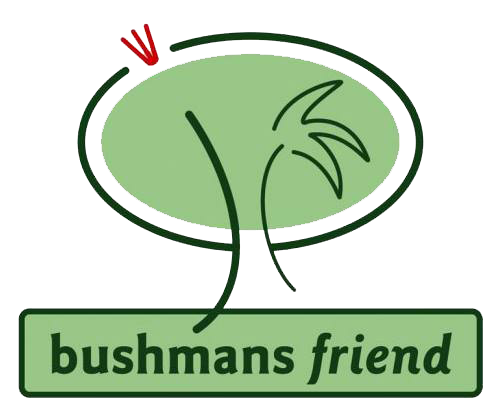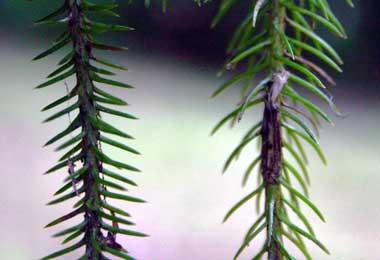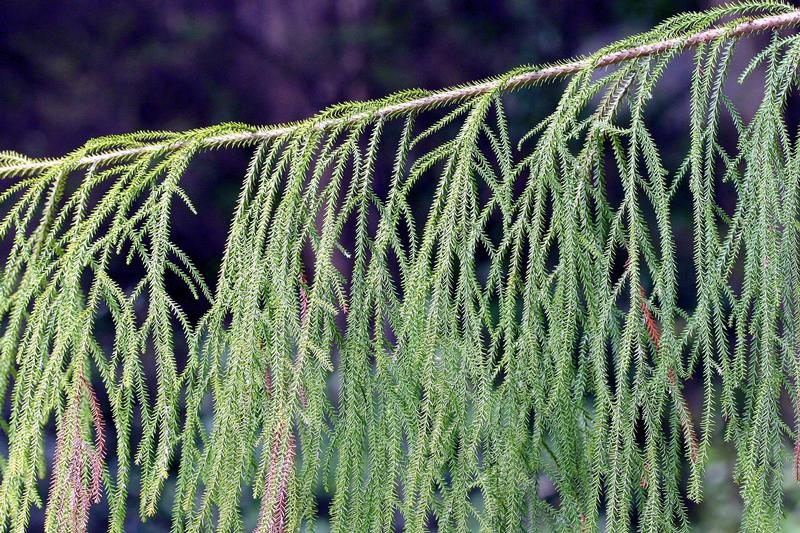
| Purchase recommended products The classic New Zealand identification guide. Every home should have one. Buy it here. Pohutukawa Diana Adams Art Print |
|
|

Dacrydium cupressinum (cypress like)
Other names : Rimu Red Pine, huarangi (the fruits)
Tree up to 35m rarely to 50m. trunk to 1.5m. or more in diameter. Bark dark brown, falling in thick flakes. Wood dark red and hard. Juvenile leaves 4-7mm 0.5-1mm wide. Adult leaves 2-3mm long, rigid. Dioecious. Fruit an ovoid nut 2mm long, seated on a red, fleshy receptacle.
The most widely occurring of all native forest trees. Prominent in many types of forest from North Cape toStewart Island.
Rimu produces, after kauri, New Zealand ’s finest wood. Heart rimu is preferred for fine furniture manufacture. It has a dark red/brown streaky grain and is harder than timber from other parts of the tree. Knots can produce wood of rich character.
Seed years occur infrequently and irregularly, generally once or twice every 10 years. Germination rate is low. The seed loses its viability if kept for any length of time. Seed is naturally dormant for at least 50 days, sometimes longer.
Every 3 or 4 years a bulk setting of seed occurs (called mast years). This could be due to environmental factors such as cool temperatures 2 years previous to seed fall when the seed is being set, plus warm temperatures in the summer of seed fall. The reproductive efficiencies assosciated with synchronising male and female reproductive effort on trees some distance from each other, may favour masting in this dioecious species. Seedfall is from mid-March to the end of April. There is often a high rate of empty or undeveloped seed. The seed is adapted well to bird dispersal which occurs from April to June. The base of the seed is joined to a sweet tasting fleshy receptacle which is swallowed along with the seed and passes through the gut, being excreted some distance from the parent tree. Birds which have been observed eating Rimu berries include: Tui, Bellbird, Whiteheads, Kereru, blackbirds, starlings and thrushes.

The Rimu is one of the most graceful trees of the country. The wood is tough and brittle: the grain very beautiful when polished and will be much admired by future connoisseurs in ornamental woods
J. Polack. New Zealand : being a narrative of travels and adventure in that country between the years 1831 and 1837
I recommend the following books on New Zealand native plants
100 Best NZ Native Plants for Gardens
The Reed Field Guide to New Zealand Native Trees
Trees and Shrubs of New Zealand
Gardener's Encyclopaedia of NZ Native Plants
A Photographic Guide to Ferns of New Zealand
New Zealand Trees and Shrubs: A Comprehensive Guide to Cultivation and Identification
From Weta to Kauri: A Guide to the NZ Forest
Which Native Forest Plant? (Which S.)
Articles